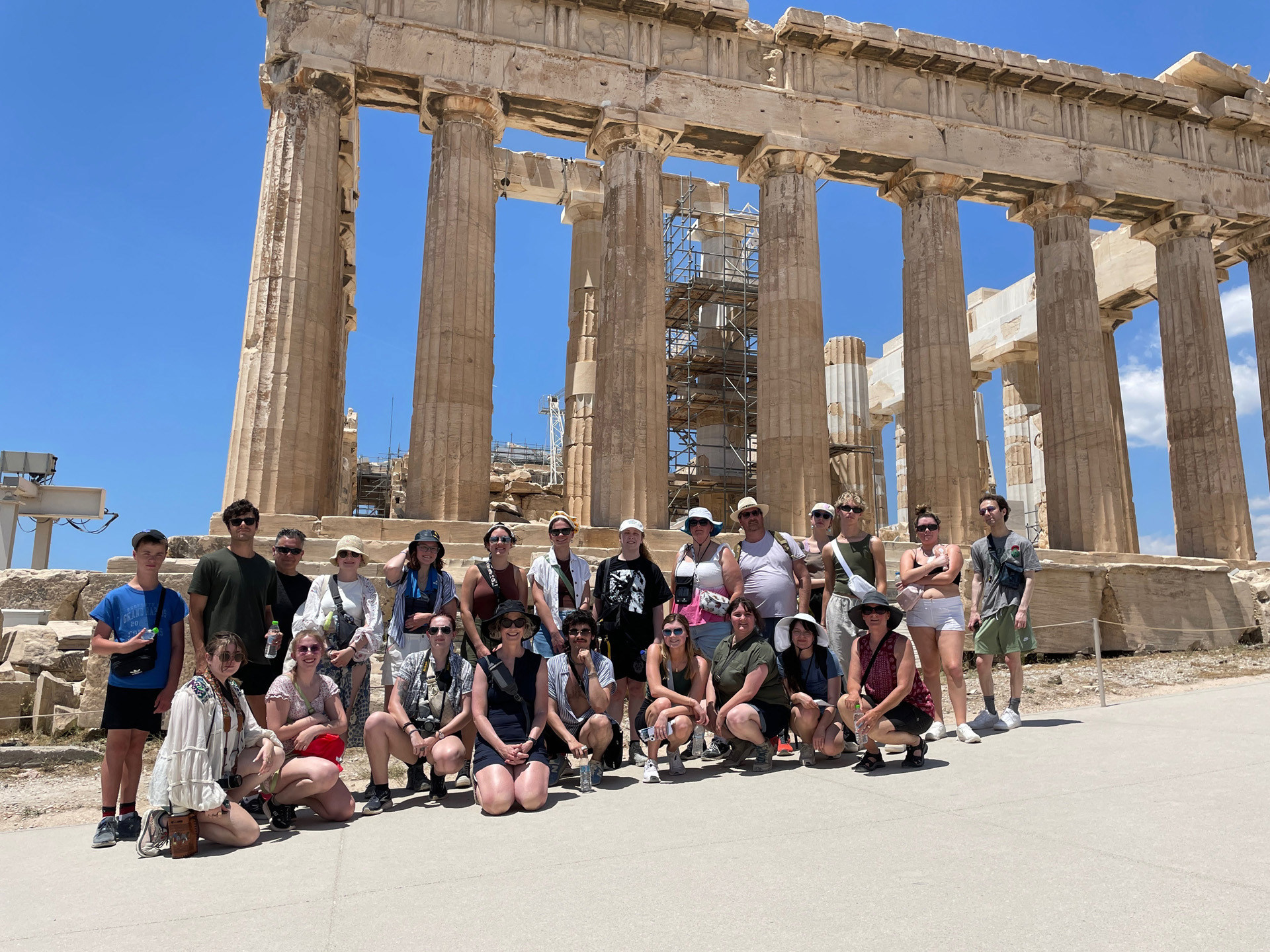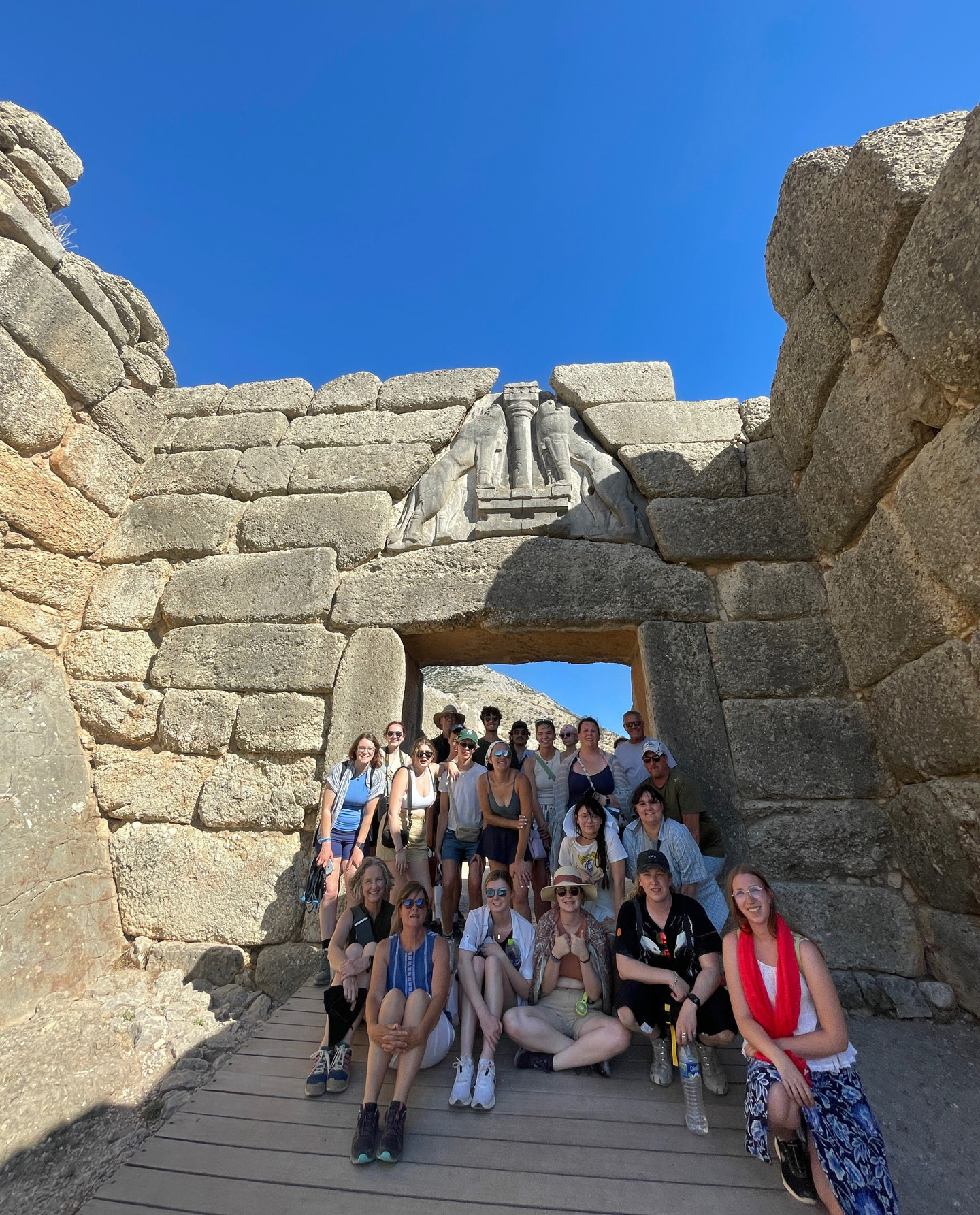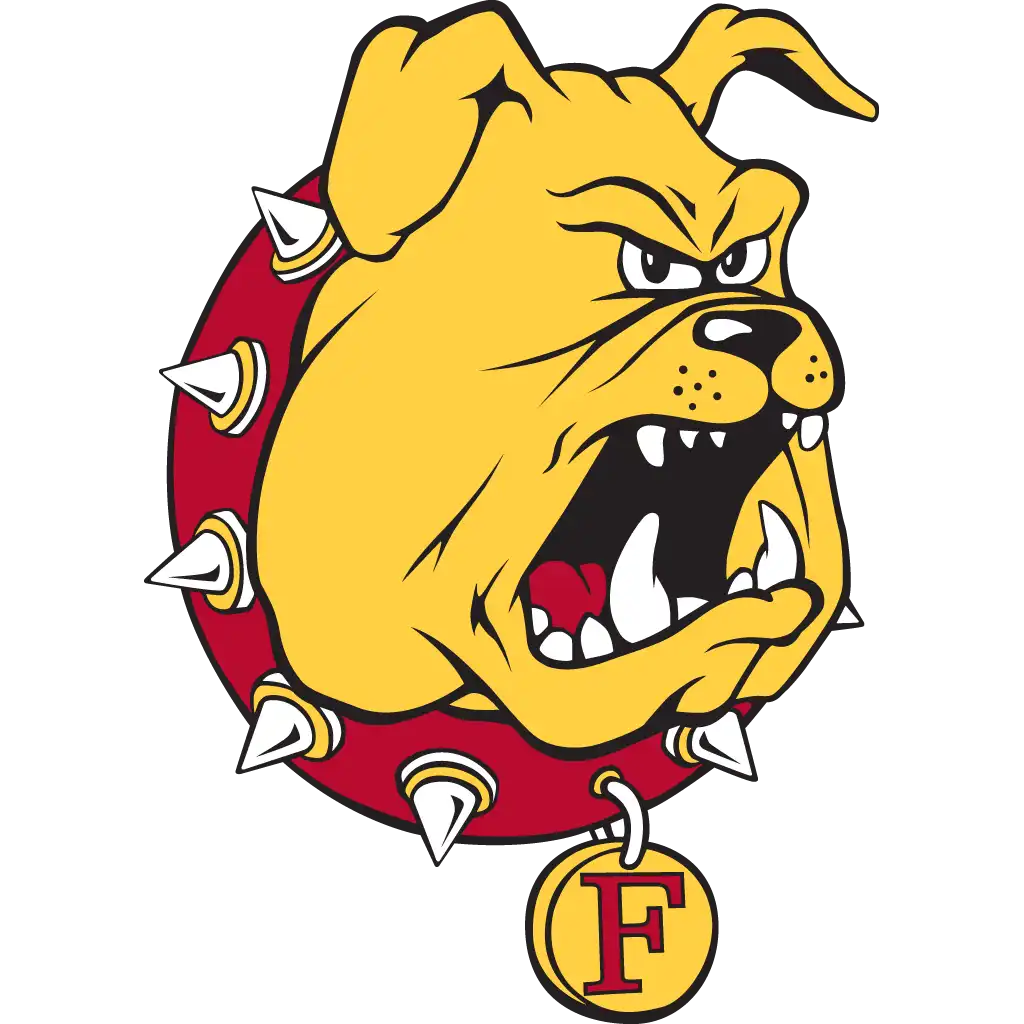Oct. 30, 2024
Students, professors from Ferris State’s KCAD push boundaries of study away model on interdisciplinary odyssey to Greece

Three professors and 18 students from Ferris State University’s Kendall College of Art and Design embarked on an odyssey to Greece inspired by Homer’s epic poem of the same name.
Organizing faculty members went beyond the traditional study away model to structure the Greece experience as a true interdisciplinary collaboration, with participating students from a wide variety of majors taking the same courses in literature, art history, and studio art.

This is a photo of the Ferris State University Kendall College of Art and Design group at Lion Gate, Mycenae.
After leading a trip to England and Wales in 2023, Art History professor and program chair Anne Norcross, General Education professor Susanna Engbers, and Product Design professor and program chair Phil Renato were motivated to find ways to encourage students to move outside of their own areas of interest and engage more meaningfully with one another.
“In planning for summer 2024, we wanted to design a different kind of program that would help bring students together as a group who would learn together and support each other,” Norcross said. “We felt that would make for a richer experience all around.”
They took their vision to Todd Stanislav, director of Ferris State University’s Faculty Center for Teaching and Learning, who was thrilled by the idea.
“I really love interdisciplinary courses; they’re a transformative experience for the faculty,” he said. “I also place great value on study abroad experiences, and their plan to help students see ideas, art, architecture, and design from multiple perspectives was really fantastic.”
Along with Stanislav’s Ferris colleagues Julie Rowan and Eric Warner, the group met to develop the program curriculum, taking nearly a year to finalize their plans. While each professor initially presented their own goals, Stanislav asked them to consider how those objectives could intersect with the other disciplines.
Together, they zeroed in on three themes woven throughout Homer’s Odyssey that they wanted every student to understand and connect meaningfully to their travel experiences: xenia (the ancient Greek practice of “guest friendship”), heroism, and transformation. As a bonus, the Faculty Center was also able to help defray the costs of the trip through a new program that covers professors’ travel expenses, thereby lowering student costs by ten percent.
Before traveling overseas, students prepared with four weeks of readings, discussions, and creative practices on KCAD’s campus. From June 13-24, they visited various locations in Greece, including Athens, the island of Hydra, a hike to the Corycian Cave, Delphi, and an archeological site in Isthmia, where they were given an extensive tour by Michigan State University Director of Excavations in Isthmia Jon Frey.
“Combining a modern, touristy city like Athens with rural areas like Hydra and Isthmia was really nice,” said Illustration student Samantha Stone. “With my love of history, and having Anne there, all the Greek art history was amazing. Seeing historical sites like the Acropolis in person was something I never expected to do. The tomb of Agamemnon was another highlight because the photos don’t do it justice. Watching everybody just geek over it was unreal!”
From Grand Rapids to Greece, all three faculty members sat in on every class, so when one was teaching, the other two were students.
“Having Anne and Phil in the room was a great example. We were demonstrating that as an educated person, you should be curious about all kinds of things,” Engbers said. “It was so powerful to have them asking questions, being confused, having insights, and pushing back against me if I said things that they didn't think were right or complete.”
Renato said this interdisciplinary approach often proved challenging for students when they were asked to integrate things in ways they had never done before. For example, after Engbers lectured about The Odyssey’s concept of guest welcome, Renato asked students to use paper to design a space where they had felt welcomed.
“What was interesting is that these students who all came to study art and design might have a more difficult time going into that studio project than discussing the literature,” he said. “Now they had this blank sheet of paper that they had to fold up into a form and figure out how to make their own meaning of.”
In another instance, Norcross led an exercise focused on close observation and visual analysis of multiple depictions on vessels from the seventh century BCE of the scene in The Odyssey in which Odysseus blinds the cyclops. Many students were surprised to see how the written narrative—as related in two of the most popular written translations of The Odyssey—doesn’t necessarily translate to visual depictions.
Looking beyond the classroom another positive outcome was the connections formed between the students on the trip.
“The idea of holding space for those who are different from us, whether that be the people we're traveling with, or the Greeks, or whatever it might be, was a theme that we tried to return to again and again. In all kinds of ways, I think it bore fruit,” Engbers said.
Stone agrees. “I'm still getting the ripple effects,” she said. “It can be hard to connect on campus, but after having that experience together, I know so many more people walking through the hallways. It definitely made me more well-rounded as a student and socially, and I want to take a lot more electives now.”
Following the trip, Stanislav and his colleagues visited KCAD to attend the final critique of students’ posters and 3D paper sculptures. Three things stood out to him: the lively interactions among the students and faculty, the evidence of the course’s goals and outcomes in the students’ work, and the interdisciplinary perspectives the faculty brought to the critique.
“A study away course brings an opportunity to step back and rethink the design of a course,” he said. “When two or more disciplines are brought to bear on a particular dilemma or question, there's a richness for students to experience. I'd love to see us provide more opportunities like this to work with faculty from different disciplines in unique study away experiences.”

